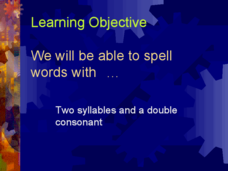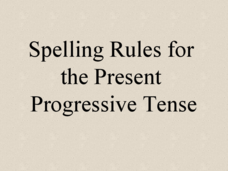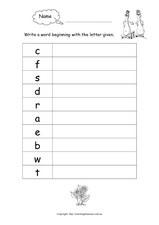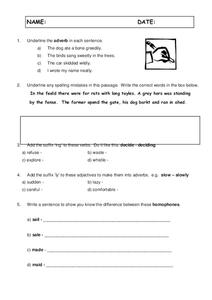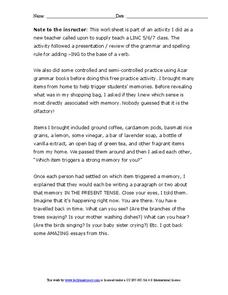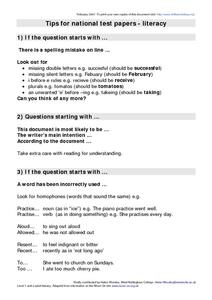Curated OER
Spelling Rules
Have your learners discuss spelling rules using this presentation. Learners talk about identifying the number of syllables in a word, adding er, ed, or ing to a word, and spelling two syllable words with double consonants.
Curated OER
Spelling Rules for the Present Progressive Tense
Help your learners change words to the present progressive tense using this presentation. Using simple words like read, leave, and sit, they add an ing ending properly to a list of words. This is a good way to introduce this topic.
Curated OER
Some Spelling Rules
This presentation offers up some of the trickier rules of the English language when it comes to spelling. For example, one slide goes over the "i before e, except after c," rule. The rest of the slides present examples like this one and...
Curated OER
Spelling Rule: v-c, double the consonant before adding -ed or -ing
Apply the spelling rule about adding suffixes to words ending with a vowel followed by a consonant with your class. Spellers read the rules and examples, observe words with suffixes, and write the root words. They write 6 answers.
Curated OER
Adding -ing
Review the rules involving the use of the -ing ending. Learners discuss a list of words, engage in activities, and learn spelling rules. This presentation provides a comprehensive review of this topic. It is a good tool for the classroom.
Core Knowledge Foundation
Third Grade Skills Unit 2: Rattenborough’s Guide to Animals
An animal-themed unit focuses on third-grade skills. Scholars practice spelling patterns, prefixes, suffixes, and grammar concepts—nouns, verbs, adjectives, subjects, predicates, and sentences. Assessments gauge proficiency.
Wesleyan College
A Review of Spelling Guidelines
In this spelling worksheet, students review and practice the basic rules of proper spellings. Students fill in twenty-five blanks with the correct spelling requested on each line.
Curated OER
Adding Suffixes
For this adding suffixes to root words worksheet, students read the spelling rule and examples, read sentences and the words at the end, and add -ed or -ing to the word to complete the sentences. Students write 8 answers.
Jumpstarting Journeys
Vowel Digraph Activities for au and aw
It can be awfully hard teaching young children how to read, but this phonics resource will make the job a little easier. Focusing on the au and aw vowel digraphs, this collection of engaging activities teaches beginning readers how to...
Curated OER
Practice Adding the ing Suffix
Second graders practice adding ing to words ending in one vowel and one consonant. In this adding ing lesson, 2nd graders participate in a teacher demonstration of adding suffixes to one vowel, one consonant words. They learn the rule...
Curated OER
Adding s, ed, and ing To Words
Second graders learn how to add s, ed, and ing suffixes to words. In this adding suffixes lesson, 2nd graders participate in a teacher led lesson on the rules for adding endings to words before completing an associated worksheet.
Essential Skills Software
Worksheet Set: Super Phonics Level 2
Supercharge beginning readers phonics skills with this extensive collection of worksheets. With exercises on long and short vowels, consonant blends, rhyming words, word endings, and much more, this resource is a primary grade teacher's...
Curated OER
Word Endings
In this word endings learning exercise, students read the root words in the left column and read the word ending rules for adding ed or ing. Students write endings for the 9 words.
Curated OER
Four Corners Spelling
Second graders participate in a spelling activity using clapping and rhythmic patterns. In this ongoing spelling lesson, 2nd graders practice various spelling words in groups and using rhythms. Students then independently spell words.
Curated OER
The Word Factory
Here is a clever way to help your 3rd and 4th graders add -ing to verbs. A list of 10 action verbs is given, and learners must adjust the spelling of each verb to accept the -ing ending. This would be an excellent choice for a homework...
Curated OER
Past Time
Review important grammatical rules. Focusing on the past tense, learners practice concepts that are used to form sentences in the past tense. This could a good activity at a center.
Curated OER
Word-building
Practice changing verb tenses and adverbs with a worksheet on vocabulary. A word bank at the top of the page instructs third and fourth graders to add -ing, -s, and -ful to different words. Great for reinforcing vocabulary rules! Use the...
Curated OER
Spelling Plurals
In this spelling plurals learning exercise, students study the 5 common rules for spelling plurals. Students fill in a chart in which the singular nouns are made plural. Then students find plurals in their reading books and classify them...
Curated OER
School-Home Links: Verb Usage 3
In this verb tense worksheet, learners review the rules for present and past tense verb usage. Students then complete each sentence by changing the given verb into either present or past tense. Parents or guardians must sign the worksheet.
Curated OER
Scent-Inspired Composition
Our sense of smell has a wonderful way of bringing back memories. Unlock those memories with an olfactory-inspired writing prompt that challenges writers to tell a story about a specific smell and the memories it conjures.
Curated OER
Adding Suffixes- ly, ful
Fifth graders practice adding suffixes. In this word endings lesson, 5th graders identify examples of suffixes, practice adding the suffix "-ly" and "-ful" and then complete a worksheet to practice.
Curated OER
Tips for National Test Papers
For this grammar worksheet, students read four tips for writing national test papers. Students also complete two tables using the correct verb forms.
English Club
English Club: Spelling Rules
This EnglishClub tutorial provides rules for spelling words. Spellings related to using -ei-, -ie-, -ible, -able, -er, -est, -ed, -ing, -ly, and -s are featured. These are followed by a link to a large set of spelling quizzes.
Other
Woodward English: Spelling Rules: Ing
Rules, exceptions, and examples of how to add -ing to verbs, dependent on the ending of the original word.


